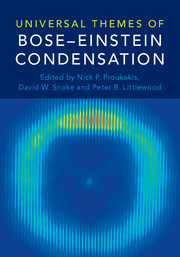Book contents
- Frontmatter
- Contents
- Foreword
- Preface
- Part I Introduction
- Part II General Topics
- Part III Condensates in Atomic Physics
- Part IV Condensates in Condensed Matter Physics
- Editorial Notes
- 19 Bose-Einstein Condensation of Photons and Grand-Canonical Condensate Fluctuations
- 20 Laser Operation and Bose-Einstein Condensation: Analogies and Differences
- 21 Vortices in Resonant Polariton Condensates in Semiconductor Microcavities
- 22 Optical Control of Polariton Condensates
- 23 Disorder, Synchronization, and Phase-locking in Nonequilibrium Bose-Einstein Condensates
- 24 Collective Topological Excitations in 1D Polariton Quantum Fluids
- 25 Microscopic Theory of Bose-Einstein Condensation of Magnons at Room Temperature
- 26 Spintronics and Magnon Bose-Einstein Condensation
- 27 Spin-Superfluidity and Spin-Current Mediated Nonlocal Transport
- 28 Bose-Einstein Condensation in Quantum Magnets
- Part V Condensates in Astrophysics and Cosmology
- Universal Bose-Einstein Condensation Workshop
- Contributors
- Index
- References
20 - Laser Operation and Bose-Einstein Condensation: Analogies and Differences
from Part IV - Condensates in Condensed Matter Physics
Published online by Cambridge University Press: 18 May 2017
- Frontmatter
- Contents
- Foreword
- Preface
- Part I Introduction
- Part II General Topics
- Part III Condensates in Atomic Physics
- Part IV Condensates in Condensed Matter Physics
- Editorial Notes
- 19 Bose-Einstein Condensation of Photons and Grand-Canonical Condensate Fluctuations
- 20 Laser Operation and Bose-Einstein Condensation: Analogies and Differences
- 21 Vortices in Resonant Polariton Condensates in Semiconductor Microcavities
- 22 Optical Control of Polariton Condensates
- 23 Disorder, Synchronization, and Phase-locking in Nonequilibrium Bose-Einstein Condensates
- 24 Collective Topological Excitations in 1D Polariton Quantum Fluids
- 25 Microscopic Theory of Bose-Einstein Condensation of Magnons at Room Temperature
- 26 Spintronics and Magnon Bose-Einstein Condensation
- 27 Spin-Superfluidity and Spin-Current Mediated Nonlocal Transport
- 28 Bose-Einstein Condensation in Quantum Magnets
- Part V Condensates in Astrophysics and Cosmology
- Universal Bose-Einstein Condensation Workshop
- Contributors
- Index
- References
Summary
After reviewing the interpretation of laser operation as a nonequilibrium Bose-Einstein condensation phase transition, we illustrate the novel features arising from the nonequilibrium nature of photon and polariton Bose-Einstein condensates recently observed in experiments. We then propose a quantitative criterion to experimentally assess the equilibrium versus nonequilibrium nature of a specific condensation process, based on fluctuation-dissipation relations. The power of this criterion is illustrated on two models which show very different behaviors.
Historical and Conceptual Introduction
The first introduction of concepts of nonequilibrium statistical mechanics into the realm of optics dates back to the early 1970s with pioneering works by Graham and Haken [1] and by DeGiorgio and Scully [2], who proposed a very insightful interpretation of the laser threshold in terms of a spontaneous breaking of the U(1) symmetry associated with the phase of the emitted light. Similar to what happens to the order parameter at a second-order phase transition, such an optical phase is randomly chosen every time the device is switched on and remains constant for macroscopic times. Moreover, a long-range spatial order is established, as light emitted by a laser device above threshold is phase-coherent on macroscopic distances.
While textbooks typically discuss this interpretation of laser operation in terms of a phase transition for the simplest case of a single-mode laser cavity, rigorously speaking this is valid only in spatially infinite systems. In fact, only in this case one can observe nonanalytic behaviors of the physical quantities at the transition point. In particular, the long-range order is typically assessed by looking at the long-distance behavior of the correlation function of the order parameter, which, for a laser, corresponds to the first-order spatial coherence of the emitted electric field,
the spontaneous symmetry breaking is signaled by this quantity becoming nonzero (see Chapter 5). The average is taken on the stationary density matrix of the system. In order to be able to probe this long-distance behavior, experimental studies need devices with a spatially extended active region.
- Type
- Chapter
- Information
- Universal Themes of Bose-Einstein Condensation , pp. 409 - 423Publisher: Cambridge University PressPrint publication year: 2017

